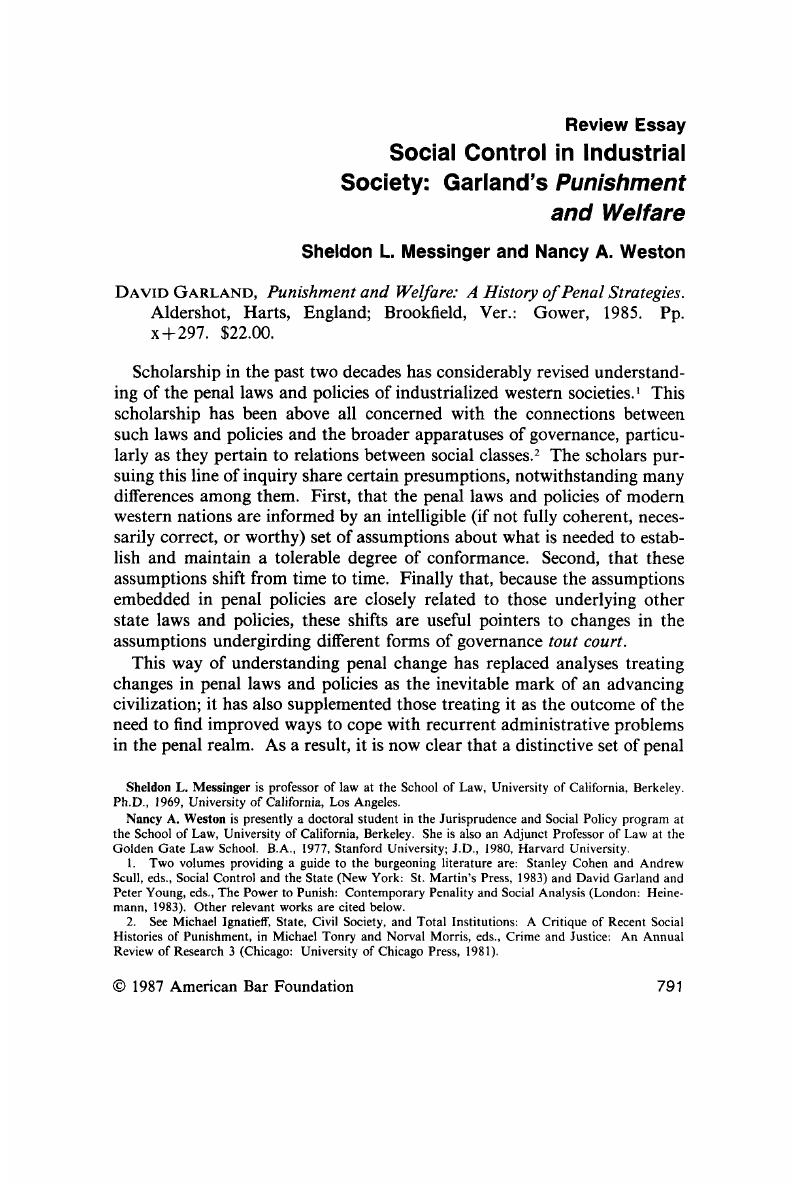Published online by Cambridge University Press: 20 November 2018

1 Two volumes providing a guide to the burgeoning literature are: Stanley Cohen and Andrew Scull, eds., Social Control and the State (New York: St. Martin's Press, 1983) and David Garland and Peter Young, eds., The Power to Punish: Contemporary Penality and Social Analysis (London: Heinemann, 1983). Other relevant works are cited below.Google Scholar
2 See Michael Ignatieff, State, Civil Society, and Total Institutions: A Critique of Recent Social Histories of Punishment, in Michael Tonry and Norval Morris, eds., Crime and Justice: An Annual Review of Research 3 (Chicago: University of Chicago Press, 1981).Google Scholar
3 Ignatieff, supra note 2.Google Scholar
4 These broad generalizations are not intended to suggest that there was no variation in the timing, penal policies or modes of governance between nations and the connections among all three. Working these out is a central preoccupation of current scholarship in this field.Google Scholar
5 The main work by Foucault dealing with penal policy is Discipline and Punish: The Birth of the Prison (New York: Pantheon Books, 1977). Madness and Civilization: A History of Insanity in the Age of Reason (New York: Vintage Books, 1973); Colin Gordon, ed., Power/Knowledge: Selected Interviews and Other Writings, 1972–1977 (New York: Pantheon, 1980); and The History of Sexuality: Volume I, An Introduction (New York: Vintage Books, 1980) might also be noted, although only Power/Knowledge deals explicitly with penal policy.Google Scholar
6 Garland specifically mentions Andrew Scull's review of David Rothman's work in Community Corrections: Panacea, Progress or Pretence?, in Garland and Young, supra note 1.Google Scholar
7 Michael Ignatieff, A Just Measure of Pain: The Penitentiary in the Industrial Revolution (New York: Pantheon, 1978).Google Scholar
8 David J. Rothman, The Discovery of the Asylum (Boston: Little, Brown, 1970). For a contemporary source, see Gustave de Beaumont and Alexis de Tocqueville, On the Penitentiary System in the United States and Its Application in France (Carbondale, IL: Southern Illinois University Press, 1964). This work was originally published in 1833.Google Scholar
9 David J. Rothman, Conscience and Convenience: The Asylum and Its Alternatives in Progressive America (Boston: Little, Brown, 1980). Others, as well, have come to broadly similar conclusions. Andrew Scull's 1977 volume, Decarceration: Community Treatment and the Deviant—A Radical View, second edition (Cambridge, England: Polity Press, 1983), argues that the emergence of the welfare state made possible the proliferation of “alternatives” to the institutional sequestering of deviant populations. Scull's focus is mainly on mental patients, but he also deals with prisoners in both the United States and Great Britain. (The first edition of Scull's volume. also containing this argument, was published in 1977.).Google Scholar
10 Francis A. Allen is one of the few authors tackling this problem to date. See his The Decline of the Rehabilitative Ideal: Penal Policy and Social Purpose (New Haven: Yale University Press, 1981).Google Scholar
11 These observations are based on and stimulated by diverse sources, some of which are: Lawrence M. Friedman and Jack Ladinsky, Social Change and the Law of Industrial Accidents, 67 Col. L. Rev. 50–82 (1967); Morton J. Horwitz, The Transformation of American Law, 1780–1860 (Cambridge, Mass: Harvard University Press, 1977); J. Willard Hurst, Law and Economic Growth: The Legal History of the Lumber Industry in Wisconsin, 1836–1915 (Cambridge, Mass.: Harvard University Press, 1964); Paul L. Murphy, The Constitution in Crisis Times, 1918–1969 (New York: Harper and Row, 1972); Arnold M. Paul, Conservative Crisis and the Rule of Law: Attitudes of Bar and Bench, 1887–1895 (Gloucester, Mass.: Peter Smith, 1976); Harry N. Scheiber, Law and the Imperatives of Progress: Private Rights and Public Values in American Legal History, in J. Roland Penrock and John W. Chapman. eds., Nomos XXIV: Ethics, Economics and the Law (1982).Google Scholar
12 The general resemblance between changes in British and American penal policy noted above give us some confidence that what we shall say about civil law changes in the United States probably have their analogue in Great Britain. We do not know enough about the British situation to discuss it specifically.Google Scholar